Enrichment Mechanism of Polymetallic Elements at the Base of the Niutitang Formation in Southeast Chongqing
Abstract
1. Introduction
2. Sample and Experiments
2.1. Geological Setting and Sample Details at the Sampling Site

2.2. Organic Geochemistry and Mineralogy Experiments
2.3. Analysis of Major and Trace Elements
3. Results
4. Discussion
4.1. Characteristics of the Sedimentary Environment of the Niutitang Formation Shale
4.1.1. Redox Conditions of Water Bodies
4.1.2. Terrestrial Input
4.2. The Relationship between Negative Excursion of δ13Corg Values and Enriched Polymetallic Elements in Lower Interval
4.3. Relationship between Polymetallic Elements and Si_excess
4.4. Sources of Polymetals and the Migration Mechanisms Controlled by Upwelling
5. Conclusions
- 1.
- Based on the Ti/Al ratio, accompanied by δ13Corg values and TOC characteristics of the shale, the Danquan Niutitang shale section in the Youyang area of Southeast Chongqing in the Upper Yangtze region can be divided into three intervals: a lower interval with highest Ti/Al ratio and lightest δ13Corg values over approximately 8 m from the base; a middle interval rich in organic matter with lowest Ti/Al ratio and relatively stable δ13Corg values from 8 to 27 m; and an upper interval above 27 m with moderate Ti/Al ratio and low TOC and TS values;
- 2.
- The negative offset of the δ13Corg values in the lower interval of the Niutitang shale in the study area, along with the strong negative correlation with Ni/TOC, Mo/TOC, V/TOC, U/TOC, as well as P and S, indicates that the mixing of upwelling fluids with anoxic sedimentary environment is the controlling factor for the negative drift of δ13Corg values and the enrichment of trace metal elements in the lower interval of the Niutitang Formation;
- 3.
- From the bottom to the top of the lower interval of Si_excessNiutitang Formation, as the influence of hydrothermal mixing weakens, the Si_excess content gradually increases, suggesting that Si_excess is primarily biogenic in origin rather than sourced from the hydrothermal fluids which are not silicon-rich;
- 4.
- Previous studies and the present research both indicate that the mixing of upwelling and local marine sediments is the primary factor for the enrichment of polymetals in the lower section of the Niutitang Formation shale in the study area.
Author Contributions
Funding
Data Availability Statement
Conflicts of Interest
References
- Li, D.; Li, R.; Tan, C.; Zhao, D.; Xue, T.; Zhao, B.; Khaled, A.; Liu, F.; Xu, F. Origin of silica, paleoenvironment, and organic matter enrichment in the Lower Paleozoic Niutitang and Longmaxi formations of the northwestern Upper Yangtze Plate: Significance for hydrocarbon exploration. Mar. Pet. Geol. 2019, 103, 404–421. [Google Scholar] [CrossRef]
- Liu, Z.; Zhuang, X.; Teng, G.; Xie, X.; Yin, L.; Bian, L.; Feng, Q.; Algeo, T. The lower Cambrian Niutitang Formation at Yangtiao (Guizhou, SW China): Organic matter enrichment, source rock potential, and hydrothermal influences. J. Pet. Geol. 2015, 38, 411–432. [Google Scholar] [CrossRef]
- Tan, J.; Wang, Z.; Wang, W.; Hilton, J.; Guo, J.; Wang, X. Depositional environment and hydrothermal controls on organic matter enrichment in the lower Cambrian Niutitang shale, southern China. AAPG Bull. 2021, 105, 1329–1356. [Google Scholar] [CrossRef]
- Wu, C.; Tuo, J.; Zhang, M.; Sun, L.; Qian, Y.; Liu, Y. Sedimentary and residual gas geochemical characteristics of the Lower Cambrian organic-rich shales in Southeastern Chongqing, China. Mar. Pet. Geol. 2016, 75, 140–150. [Google Scholar] [CrossRef]
- Kříbek, B.; Sýkorová, I.; Pašava, J.; Machovič, V. Organic geochemistry and petrology of barren and Mo–Ni–PGE mineralized marine black shales of the Lower Cambrian Niutitang Formation (South China). Int. J. Coal Geol. 2007, 72, 240–256. [Google Scholar] [CrossRef]
- Xie, G.; Liu, S.; Xia, G.; Hao, W. Mineralogy and geochemical investigation of Cambrian and Ordovician–Silurian shales in South China: Implication for potential environment pollutions. Geol. J. 2018, 55, 477–500. [Google Scholar] [CrossRef]
- Pi, D.; Liu, C.; Shields-Zhou, G.A.; Jiang, S.Y. Trace and rare earth element geochemistry of black shale and kerogen in the early Cambrian Niutitang Formation in Guizhou province, South China: Constraints for redox environments and origin of metal enrichments. Precambrian Res. 2013, 225, 218–229. [Google Scholar] [CrossRef]
- Jiang, S.; Chen, Y.; Ling, H.; Yang, J.; Feng, H.; Ni, P. Trace-and rare-earth element geochemistry and Pb–Pb dating of black shales and intercalated Ni–Mo–PGE–Au sulfide ores in Lower Cambrian strata, Yangtze Platform, South China. Miner. Depos. 2006, 41, 453–467. [Google Scholar] [CrossRef]
- Jiang, T.; Jin, Z.; Liu, G.; Liu, Q.; Gao, B.; Liu, Z.; Nie, H.; Zhao, J.; Wang, R.; Zhu, T.; et al. Source analysis of siliceous minerals and uranium in Early Cambrian shales, South China: Significance for shale gas exploration. Mar. Pet. Geol. 2019, 102, 101–108. [Google Scholar] [CrossRef]
- Xia, W.; Yu, B.; Sun, M. Depositional setting and enrichment mechanism of organic matter of the black shales of Niutitang Formation at the bottom of Lower Cambrian, in well YuKe1, Southeast Chongqing. Mineral. Petrol. 2015, 35, 70–80, (In Chinese with English Abstract). [Google Scholar] [CrossRef]
- Zhao, K.; Jiang, S.; Chen, W.; Chen, P.; Ling, H. Mineralogy, geochemistry and ore genesis of the Dawan uranium deposit in southern Hunan Province, South China. J. Geochem. Explor. 2014, 138, 59–71. [Google Scholar] [CrossRef]
- Zhao, W.; Xie, Z.; Wang, X.; Zhen, A.; Wei, G.; Wang, Z.; Wang, K. Sinian gas sources and effectiveness of primary gas-bearing system in Sichuan Basin, SW China. Pet. Explor. Dev. 2021, 48, 1089–1099, (In Chinese with English Abstract). [Google Scholar] [CrossRef]
- Liu, T.; Jiang, Z.; Liu, W.; Zhang, K.; Xie, X.; Yin, L.; Huang, Y. Effect of hydrothermal activity on the enrichment of sedimentary organic matter at Early Cambrian in the Xiuwu Basin. Pet. Geol. Recovery Effic. 2018, 25, 68–76, (In Chinese with English Abstract). [Google Scholar] [CrossRef]
- Ma, Y.; Lu, Y.; Liu, X.; Zhai, G.; Wang, Y.; Zhang, C. Depositional environment and organic matter enrichment of the lower Cambrian Niutitang shale in western Hubei Province, South China. Mar. Pet. Geol. 2019, 109, 381–393. [Google Scholar] [CrossRef]
- Li, Y.; Zhang, C.; Chi, G.; Duo, J.; Li, Z.; Song, H. Black and red alterations associated with the Baimadong uranium deposit (Guizhou, China): Geological and geochemical characteristics and genetic relationship with uranium mineralization. Ore Geol. Rev. 2019, 111, 102981. [Google Scholar] [CrossRef]
- Niu, X.; Yan, D.; Zhuang, X.; Liu, Z.; Li, B.; Wei, X.; Xu, H.; Li, D. Origin of quartz in the lower Cambrian Niutitang Formation in south Hubei Province, upper Yangtze platform. Mar. Pet. Geol. 2018, 96, 271–287. [Google Scholar] [CrossRef]
- Gao, P.; He, Z.; Lash, G.G.; Zhou, Q.; Xiao, X. Controls on silica enrichment of lower cambrian organic-rich shale deposits. Mar. Pet. Geol. 2021, 130, 105126. [Google Scholar] [CrossRef]
- Yeasmin, R.; Chen, D.; Fu, Y.; Wang, J.; Guo, Z.; Guo, C. Climatic-oceanic forcing on the organic accumulation across the shelf during the Early Cambrian (Age 2 through 3) in the mid-upper Yangtze Block, NE Guizhou, South China. J. Asian Earth Sci. 2017, 134, 365–386. [Google Scholar] [CrossRef]
- Guo, Q.; Strauss, H.; Zhu, M.; Zhang, J.; Yang, X.; Lu, M. High resolution organic carbon isotope stratigraphy from a slope to basinal setting on the Yangtze platform, south China: Implications for the Ediacaran–Cambrian transition. Precambrian Res. 2013, 225, 209–217. [Google Scholar] [CrossRef]
- Goldberg, T.; Strauss, H.; Guo, Q.; Liu, C. Reconstructing marine redox conditions for the Early Cambrian Yangtze Platform: Evidence from biogenic sulphur and organic carbon isotopes. Palaeogeogr. Palaeoclimatol. Palaeoecol. 2007, 254, 175–193. [Google Scholar] [CrossRef]
- Wang, K.; Deng, J.; Hao, X. The geochemical behavior of uranium and mineralization: South China uranium province as an example. Acta Petrol. Sin. 2020, 36, 35–43. [Google Scholar] [CrossRef]
- Steiner, M.; Li, G.; Qian, Y.; Zhu, M.; Erdtmann, B.D. Neoproterozoic to early Cambrian small shelly fossil assemblages and a revised biostratigraphic correlation of the Yangtze Platform (China). Palaeogeogr. Palaeoclimatol. Palaeoecol. 2007, 254, 67–99. [Google Scholar] [CrossRef]
- Chen, D.; Wang, H.; Qing, H.; Yan, D.; Li, R. Hydrothermal venting activities in the Early Cambrian, South China: Petrological, geochronological and stable isotopic constraints. Chem. Geol. 2009, 258, 168–181. [Google Scholar] [CrossRef]
- Gao, P.; He, Z.; Li, S.; Lash, G.G.; Li, B.; Huang, B.; Yan, D. Volcanic and hydrothermal activities recorded in phosphate nodules from the Lower Cambrian Niutitang Formation black shales in South China. Palaeogeogr. Palaeoclimatol. Palaeoecol. 2018, 505, 381–397. [Google Scholar] [CrossRef]
- Zhu, M.; Zhang, J.; Yang, A.; Li, G.; Steiner, M.; Erdtmann, B.D. Sinian-Cambrian stratigraphic framework for shallow-to deep-water environments of the Yangtze Platform: An integrated approach. Progress. Nat. Sci. 2003, 13, 951–960. [Google Scholar] [CrossRef]
- Zhao, Z.; Yu, Q.; Zhou, X.; Liu, W.; He, J.; Xie, Y. Shale gas accumulation conditions of the Niutitang Formation of Lower Cambrian in Qianjiang Area, Chongqing. Geol. Sci. Technol. Inf. 2017, 36, 122–129, (In Chinese with English Abstract). [Google Scholar]
- Holdaway, H.K.; Clayton, C.J. Preservation of shell microstructure in silicified brachiopods from the Upper Cretaceous Wilmington Sands of Devon. Geol. Mag. 1982, 119, 371–382. [Google Scholar] [CrossRef]
- Zhang, K.; Jiang, Z.; Yin, L.; Gao, Z.; Wang, P.; Song, Y.; Jia, C.; Liu, W.; Liu, T.; Xie, X.; et al. Controlling functions of hydrothermal activity to shale gas content-taking lower Cambrian in Xiuwu Basin as an example. Mar. Pet. Geol. 2017, 85, 177–193. [Google Scholar] [CrossRef]
- Chen, X.; Ling, H.F.; Vance, D.; Shields-Zhou, G.A.; Zhu, M.; Poulton, S.W.; Och, M.L.; Jiang, S.; Cremonese, L.; Archer, C. Rise to modern levels of ocean oxygenation coincided with the Cambrian radiation of animals. Nat. Commun. 2015, 6, 7142. [Google Scholar] [CrossRef]
- Leventhal, J. Comparative geochemistry of metals and rare earth elements from the Cambrian alum shale and kolm of Sweden. In Proceedings of the Sediment-Hosted Mineral Deposits: Proceedings of a Symposium, Beijing, China, 30 July–4 August 1988; Wiley: Hoboken, NJ, USA, 1990; pp. 203–215. [Google Scholar] [CrossRef]
- Zhang, Y.; Yan, D.; Zhang, F.; Li, X.; Qiu, L.; Zhang, Y. Stratigraphic sequences, abundance anomalies and occurrences of as, Sb, Au, Ag in the lower cambrian Niutitang formation in kaiyang phosphate mine area. Acta Petrol. Sin. 2016, 32, 3252–3268, (In Chinese with English Abstract). [Google Scholar]
- Yang, J.; Yi, F.C.; Hou, L.J. Genesis and petrogeochemistry characteristics of Lower Cambrian black shale series in northern Guizhou. Acta Mineral. Sin. 2004, 24, 285–289, (In Chinese with English Abstract). [Google Scholar] [CrossRef]
- Cao, H.; Wang, Z.; Dong, L.; Xiao, Y.; Hu, L.; Chen, F.; Wei, K.; Chen, C.; Song, Z.; Wu, L. Influence of hydrothermal and upwelling events on organic matter accumulation in the gas-bearing lower Cambrian shales of the middle Yangtze Block, South China. Mar. Pet. Geol. 2023, 155, 106373. [Google Scholar] [CrossRef]
- LaGrange, M.T.; Konhauser, K.O.; Catuneanu, O.; Harris, B.S.; Playter TL Gingras, M.K. Sequence stratigraphy in organic-rich marine mudstone successions using chemostratigraphic datasets. Earth-Sci. Rev. 2020, 203, 103137. [Google Scholar] [CrossRef]
- Dong, L.; Huang, Y.; Li, W.; Duan, C.; Luo, M.; Ren, S. Understanding Hydrothermal Activity and Organic Matter Enrichment with the Geochemical Characteristics of Black Shales in Lower Cambrian, Northwestern Hunan, South China. Lithosphere 2022, 2022, 2241381. [Google Scholar] [CrossRef]
- Scott, C.; Lyons, T.W.; Bekker, A.; Shen, Y.; Poulton, S.W.; Chu XAnbar, A.D. Tracing the stepwise oxygenation of the Proterozoic ocean. Nature 2008, 452, 456–459. [Google Scholar] [CrossRef]
- Wu, D.; Purnomo, B.J.; Sun, S. As and Sb speciation in relation with physico-chemical characteristics of hydrothermal waters in Java and Bali. J. Geochem. Explor. 2017, 173, 85–91. [Google Scholar] [CrossRef]
- Li, R.; Lu, J.; Zhang, S.; Lei, J. Organic carbon isotopic composition of Sinian and Early Cambrian black shales. Sci. China Ser. D 1999, 29, 351–357, (In Chinese with English Abstract). [Google Scholar] [CrossRef]
- Yang, R.; Zhu, L.; Gao, H.; Zhang, W.; Jiang, L.; Wang, Q.; Bao, M. A study on characteristics of the hydrothermal vent and relating biota at the Cambrian bottom in Songlin, Zunyi County, Guizhou province. Geol. Rev. 2005, 51, 481–492, (In Chinese with English Abstract). [Google Scholar]
- Awan, R.S.; Liu, C.; Gong, H.; Dun, C.; Tong, C.; Chamssidini, L.G. Paleo-sedimentary environment in relation to enrichment of organic matter of Early Cambrian black rocks of Niutitang Formation from Xiangxi area China. Mar. Pet. Geol. 2020, 112, 104057. [Google Scholar] [CrossRef]
- Bristow, T.F.; Bonifacie, M.; Derkowski, A.; Eiler, J.M.; Grotzinger, J.P. A hydrothermal origin for isotopically anomalous cap dolostone cements from south China. Nature 2011, 474, 68–71. [Google Scholar] [CrossRef]
- Sahoo, S.K.; Planavsky, N.J.; Kendall, B.; Wang, X.; Shi, X.; Scott, C.; Anbar, A.D.; Lyons, T.W.; Jiang, G. Ocean oxygenation in the wake of the Marinoan glaciation. Nature 2012, 489, 546–549. [Google Scholar] [CrossRef] [PubMed]
- Jiang, G.; Wang, X.; Shi, X.; Xiao, S.; Zhang, S.; Dong, J. The origin of decoupled carbonate and organic carbon isotope signatures in the early Cambrian (ca. 542–520 Ma) Yangtze platform. Earth Planet. Sci. Lett. 2012, 317, 96–110. [Google Scholar] [CrossRef]
- Cremonese, L.; Shields-Zhou, G.; Struck, U.; Ling, H.F.; Och, L.; Chen, X.; Li, D. Marine biogeochemical cycling during the early Cambrian constrained by a nitrogen and organic carbon isotope study of the Xiaotan section, South China. Precambrian Res. 2013, 225, 148–165. [Google Scholar] [CrossRef]
- Chang, C.; Hu, W.; Fu, Q.; Cao, J.; Wang, X.; Yao, S. Characterization of trace elements and carbon isotopes across the Ediacaran-Cambrian boundary in Anhui Province, South China: Implications for stratigraphy and paleoenvironment reconstruction. J. Asian Earth Sci. 2016, 125, 58–70. [Google Scholar] [CrossRef]
- Maheshwari, A.; Sial, A.N.; Mathur, S.C. Carbon isotope fluctuations through the neoproterozoic-lower Cambrian Birmania basin, Rajasthan, India. Carbonates Evaporites 2002, 17, 53–59. [Google Scholar] [CrossRef]
- Kirschvink, J.L.; Ripperdan, R.L.; Evans, D.A. Evidence for a large-scale reorganization of Early Cambrian continental masses by inertial interchange true polar wander. Science 1997, 277, 541–545. [Google Scholar] [CrossRef]
- Kirschvink, J.L.; Raub, T.D. A methane fuse for the Cambrian explosion: Carbon cycles and true polar wander. Comptes Rendus Geosci. 2003, 335, 65–78. [Google Scholar] [CrossRef]
- Fu, Y.; Yang, Z.; Li, C.; Xia, P. Enrichment of platinum group elements in Lower Cambrian polymetallic black shale, SE Yangtze Block, China. Front. Earth Sci. 2021, 9, 651948. [Google Scholar] [CrossRef]
- Mao, J.; Lehmann, B.; Du, A.; Zhang, G.; Ma, D.; Wang, Y. Re-Os dating of polymetallic Ni-Mo-PGE-Au mineralization in lower cambrian black shales of South China and its geologic significance. Econ. Geol. 2002, 97, 1051–1061. [Google Scholar] [CrossRef]
- Jin, C.; Li, C.; Algeo, T.J.; Wu, S.; Cheng, M.; Zhang, Z.; Shi, W. Controls on organic matter accumulation on the early-Cambrian western Yangtze Platform, South China. Mar. Pet. Geol. 2020, 111, 75–87. [Google Scholar] [CrossRef]
- Jiang, S.Y.; Yang, J.H.; Ling, H.F.; Chen, Y.Q.; Feng, H.Z.; Zhao, K.D.; Ni, P. Extreme enrichment of polymetallic Ni–Mo–PGE–Au in Lower Cambrian black shales of South China: An Os isotope and PGE geochemical investigation. Palaeogeogr. Palaeoclimatol. Palaeoecol. 2007, 254, 217–228. [Google Scholar] [CrossRef]
- Fu, Y.; Dong, L.; Li, C.; Qu, W.; Pei, H.; Qiao, W.; Shen, B. New Re-Os isotopic constrains on the formation of the metalliferous deposits of the Lower Cambrian Niutitang formation. J. Earth Sci. 2016, 27, 271–281. [Google Scholar] [CrossRef]
- Zhang, G.; Chen, D.; Ding, Y.; Huang, T. Controls on Organic Matter Accumulation from an Upper Slope Section on the Early Cambrian Yangtze Platform, South China. Minerals 2023, 13, 260. [Google Scholar] [CrossRef]
- Liu, Z.; Yan, D.; Yuan, D.; Niu, X.; Fu, H. Multiple controls on the organic matter accumulation in early Cambrian marine black shales, middle Yangtze Block, South China. J. Nat. Gas. Sci. Eng. 2022, 100, 104454. [Google Scholar] [CrossRef]
- Zhang, Q.; Liu, E.; Pan, S.; Wang, H.; Jing, Z.; Zhao, Z.; Zhu, R. Multiple Controls on Organic Matter Accumulation in the Intraplatform Basin of the Early Cambrian Yangtze Platform, South China. J. Mar. Sci. Eng. 2023, 11, 1907. [Google Scholar] [CrossRef]
- Tribovillard, N.; Algeo, T.J.; Lyons, T.; Riboulleau, A. Trace metals as paleoredox and paleoproductivity proxies: An update. Chem. Geol. 2006, 232, 12–32. [Google Scholar] [CrossRef]
- Zhu, G.; Zhao, K.; Li, T.; Zhang, Z.; Tang, S.; Wang, P. Anomalously high enrichment of mercury in early Cambrian black shales in South China. J. Asian Earth Sci. 2021, 216, 104794. [Google Scholar] [CrossRef]
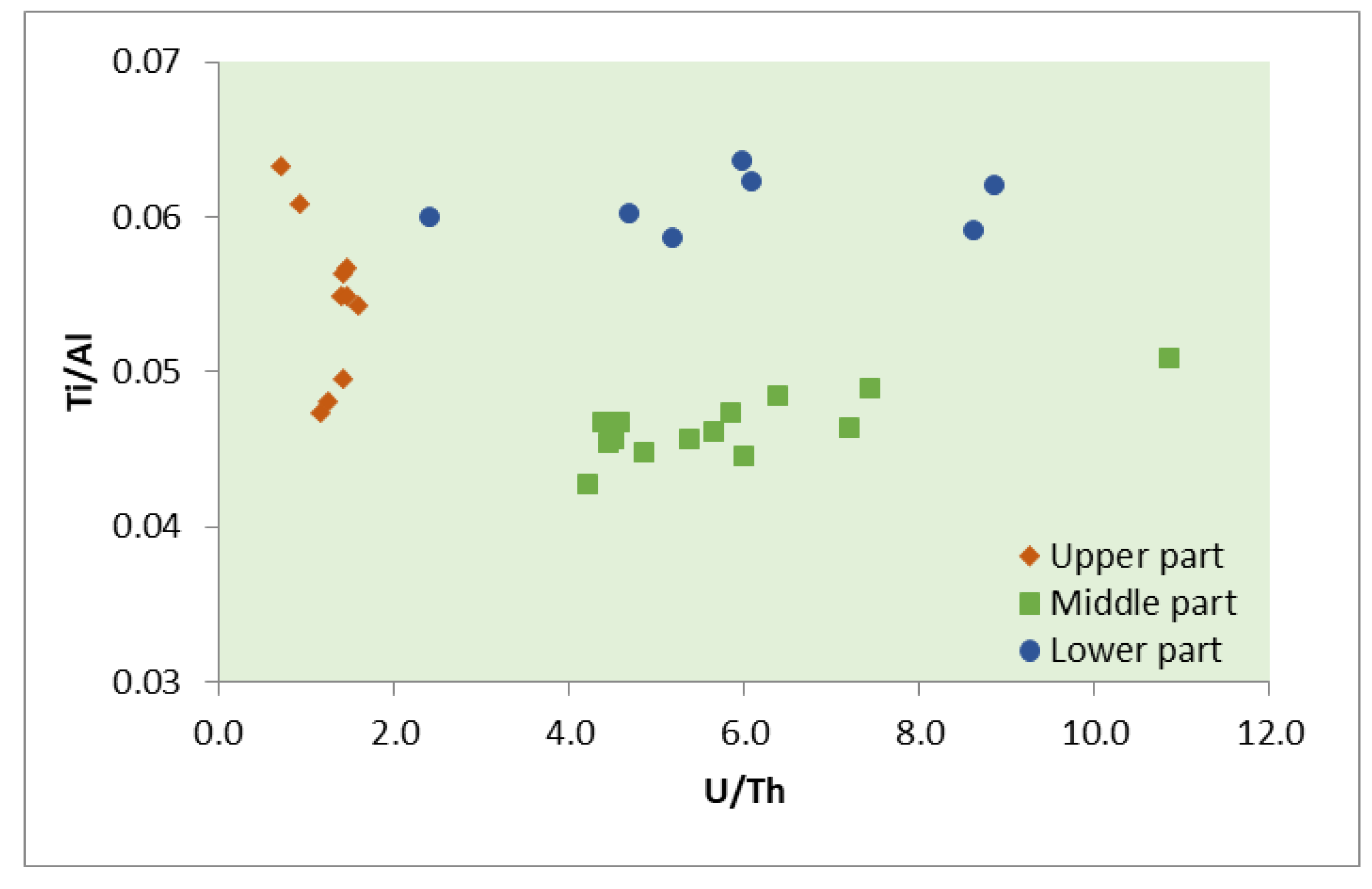
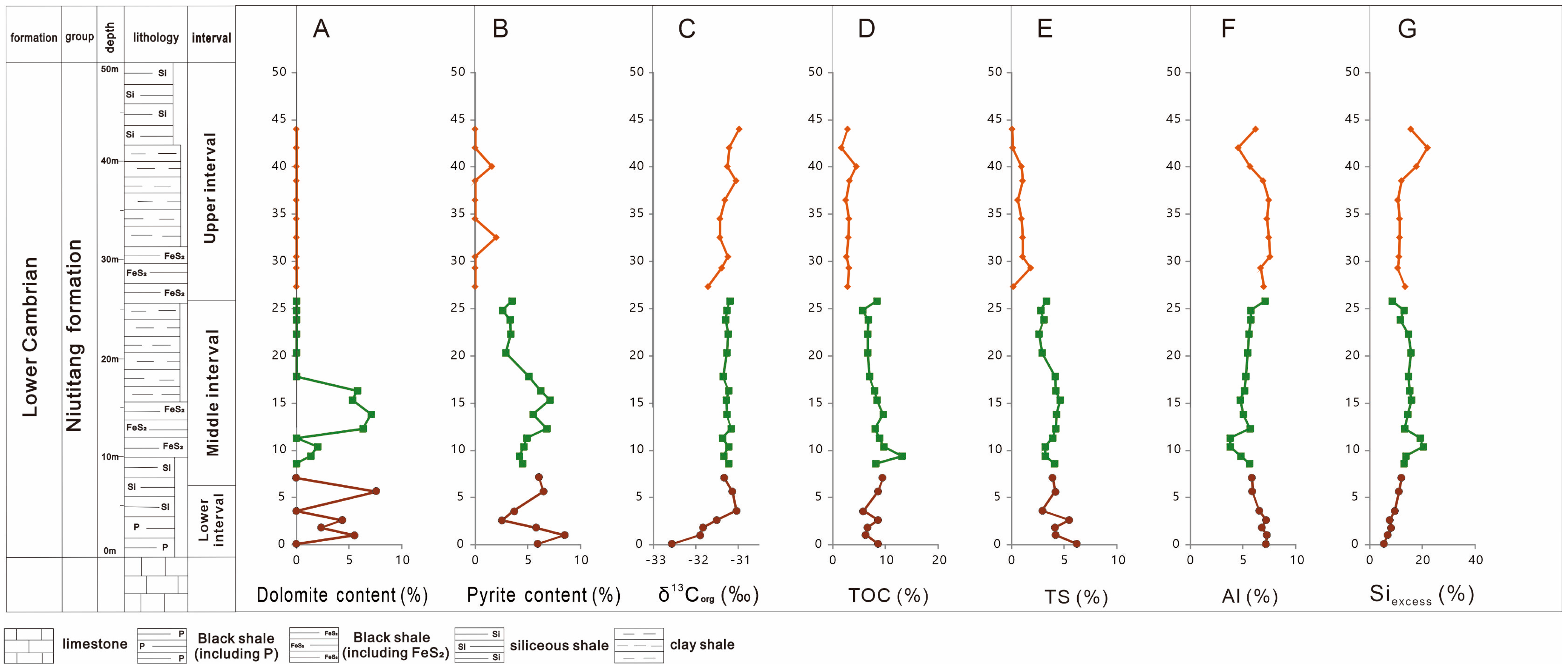
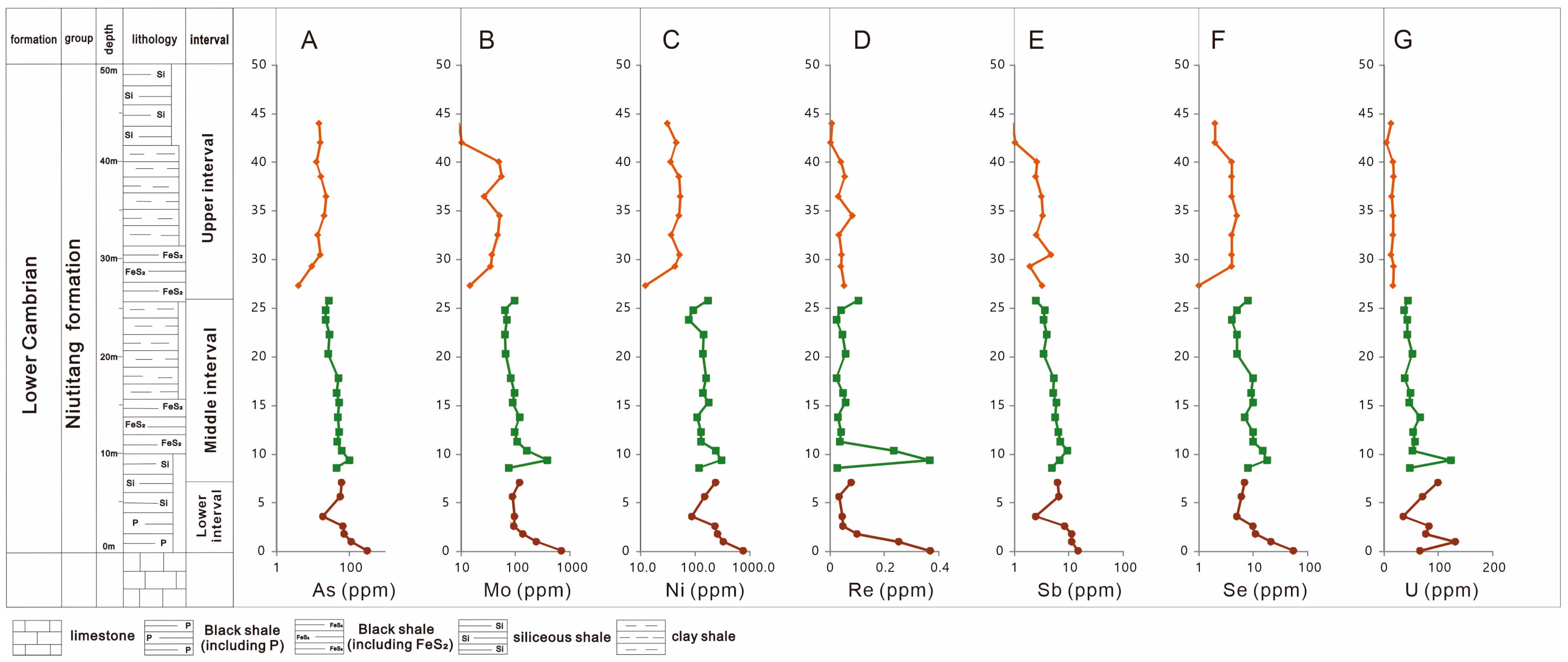




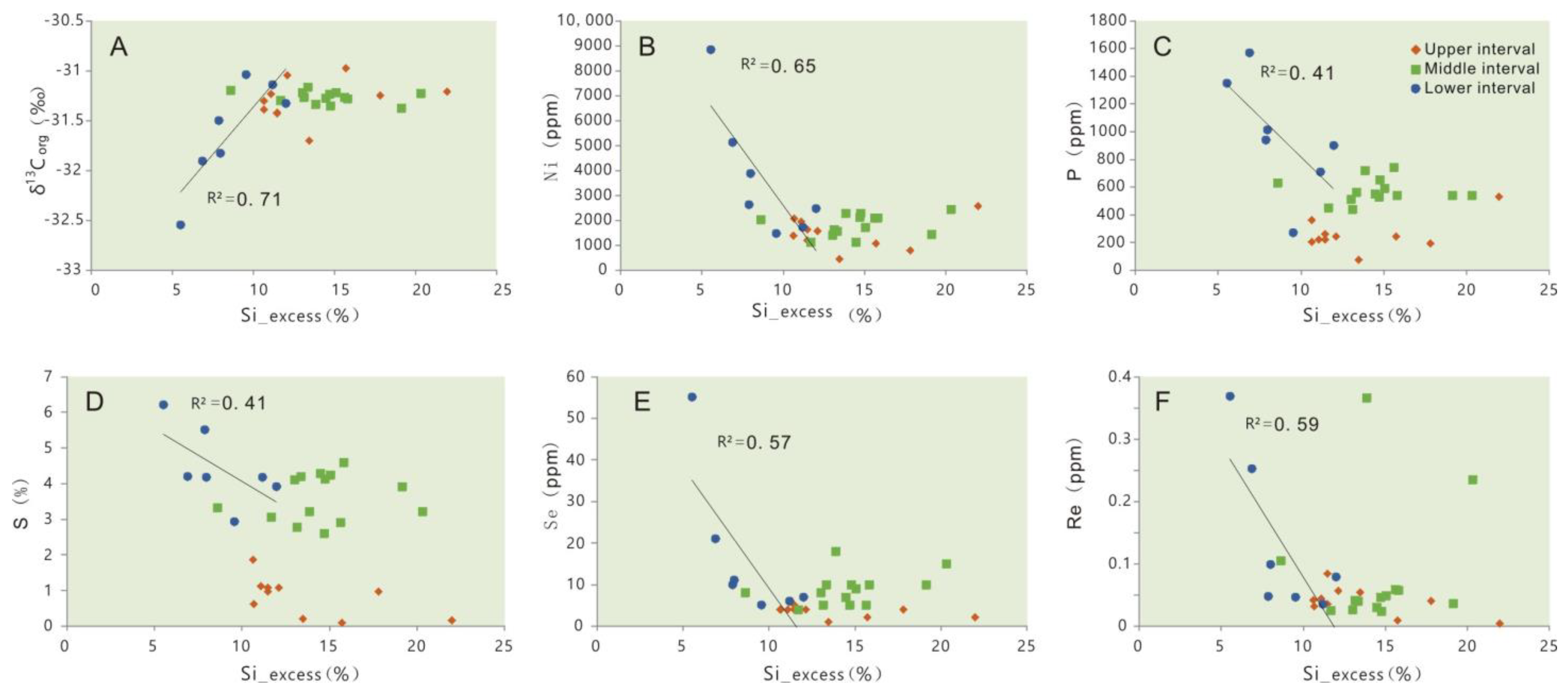
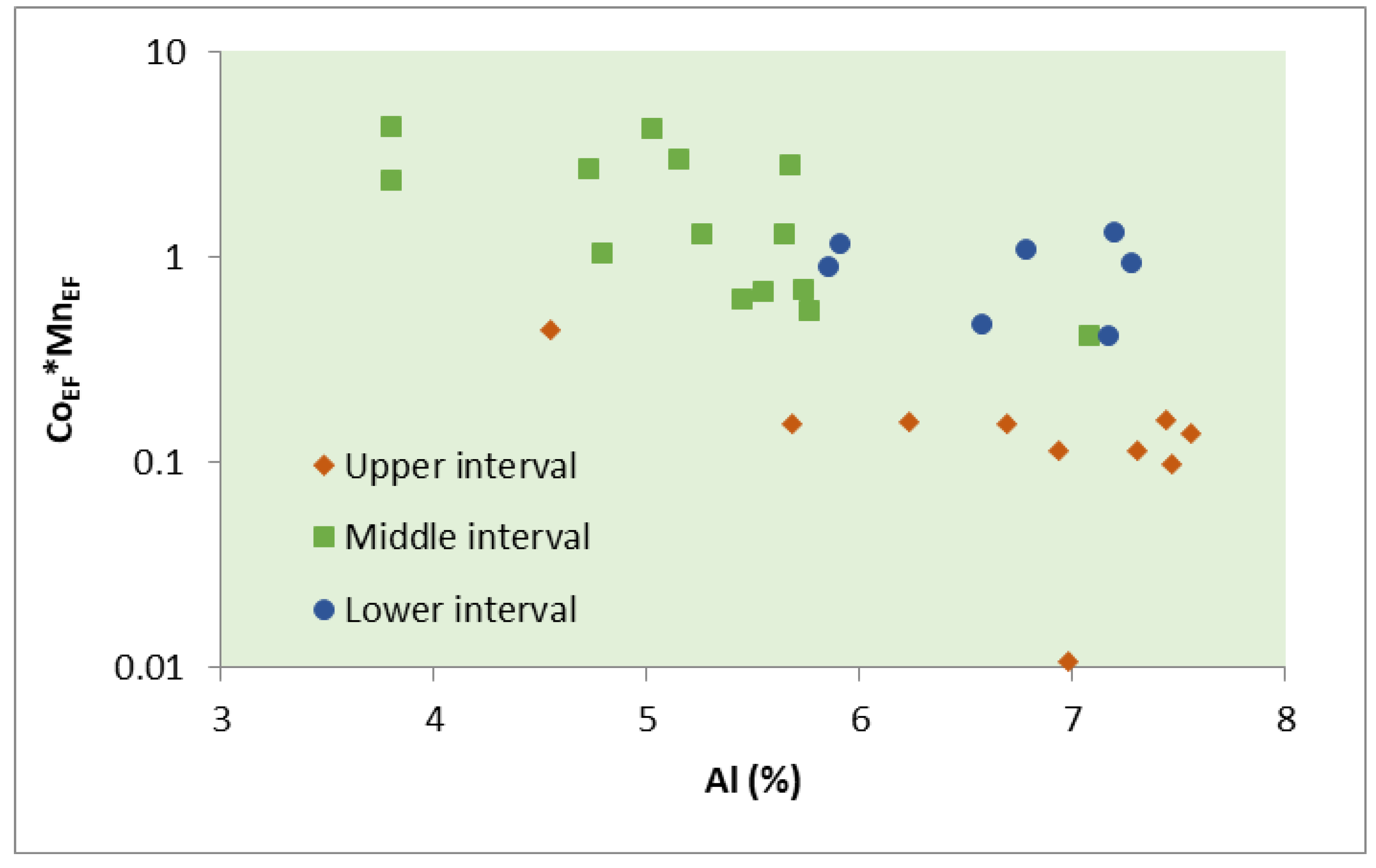
Disclaimer/Publisher’s Note: The statements, opinions and data contained in all publications are solely those of the individual author(s) and contributor(s) and not of MDPI and/or the editor(s). MDPI and/or the editor(s) disclaim responsibility for any injury to people or property resulting from any ideas, methods, instructions or products referred to in the content. |
© 2024 by the authors. Licensee MDPI, Basel, Switzerland. This article is an open access article distributed under the terms and conditions of the Creative Commons Attribution (CC BY) license (https://creativecommons.org/licenses/by/4.0/).
Share and Cite
Wang, G.; Zhang, C.; Liu, D.; Qiu, L.; Li, Z.; Peng, P. Enrichment Mechanism of Polymetallic Elements at the Base of the Niutitang Formation in Southeast Chongqing. Minerals 2024, 14, 978. https://doi.org/10.3390/min14100978
Wang G, Zhang C, Liu D, Qiu L, Li Z, Peng P. Enrichment Mechanism of Polymetallic Elements at the Base of the Niutitang Formation in Southeast Chongqing. Minerals. 2024; 14(10):978. https://doi.org/10.3390/min14100978
Chicago/Turabian StyleWang, Guozhi, Can Zhang, Dayong Liu, Linfei Qiu, Ziying Li, and Ping’an Peng. 2024. "Enrichment Mechanism of Polymetallic Elements at the Base of the Niutitang Formation in Southeast Chongqing" Minerals 14, no. 10: 978. https://doi.org/10.3390/min14100978
APA StyleWang, G., Zhang, C., Liu, D., Qiu, L., Li, Z., & Peng, P. (2024). Enrichment Mechanism of Polymetallic Elements at the Base of the Niutitang Formation in Southeast Chongqing. Minerals, 14(10), 978. https://doi.org/10.3390/min14100978






